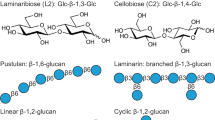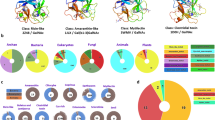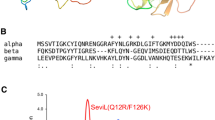Abstract
Human mannose-binding protein is a hexamer of trimers with each subunit consisting of an amino-terminal region rich in cysteine, 19 collagen repeats, a ‘neck’, and a carbohydrate recognition domain that requires calcium to bind ligand. A 148-residue peptide, consisting of the ‘neck’ and carbohydrate recognition domains forms trimers in solution and in crystals. The structure of this trimeric peptide has been determined in two different crystal forms. The ‘neck’ forms a triple α-helical coiled-coil. Each α-helix interacts with a neighbouring carbohydrate recognition domain. The spatial arrangement of the carbohydrate recognition domains suggest how MBP trimers form the basic recognition unit for branched oligosaccharides on microorganisms.
This is a preview of subscription content, access via your institution
Access options
Subscribe to this journal
Receive 12 print issues and online access
$209.00 per year
only $17.42 per issue
Buy this article
- Purchase on SpringerLink
- Instant access to full article PDF
Prices may be subject to local taxes which are calculated during checkout
Similar content being viewed by others
References
Sastry, K. & Ezekowitz, R. A. Collectins: pattern recognition molecules involved in first line host defense. Curr. Opin. Immunol. 5, 59–66 (1993).
Holmskov, U., Malhotra, R., Sim, R.B. & Jensenius, J.C. Collectins: collagenous C-type lectins of the innate immune defense system. Immunol. Today 15, 67–74 (1994).
Hoppe, H.-J. & Reid, K.B.M. Collectins—soluble proteins containing collagenous regions and lectin domains—and their roles in innate immunity. Protein Sci. 3, 1143–1158 (1994).
Ezekowitz, R.A.B. Ante-antibody immunity. Curr. Biol. 1, 60–62 (1991).
Super, M., Thiel, S., Lu, J., Levinsky, R.J. & Turner, M.W. Association of low levels of mannan-binding protein with a common defect of opsonisation. Lancet 2, 1236–1239 (1989).
Ikeda, K., Sannoh, T., Kawasaki, N., Kawasaki, T. & Yamashina, I. Serum lectin with known structure activates complement through the classical pathway. J. biol. Chem. 262, 7451–7454 (1987).
Lu, J., Thiel, S., Wiedemann, H., Timpl, R. & Reid, K.B.M. Binding of the pentamer/hexamer forms of mannan-binding protein to zymosan activates the proenzyme C1r2C1s2 complex, of the classical pathway of complement, without involvement of C1q. J. Immunol. 144, 2287–2294 (1990).
Schweinle, J.E., Ezekowitz, R.A.B., Tenner, A.J., Kuhlman, M. & Joiner, K. A human mannose-binding protein activates the alternative complement pathway and enhances serum bactericidal activity on a mannose-rich isolate of Salmonella. J. clin. Invest. 84, 1821–1829 (1989).
Matsushita, M. & Fujita, T. Activate of the classical complement pathway by mannose-binding protein in association with a novel C1s-like serine protease. J. exp. Med. 176, 1497–1502 (1992).
Drickamer, K., Dordal, M.S. & Reynolds, L. Mannose-binding proteins isolated from rat liver contain carbohydrate-recognition domains linked to collagenous tails: Complete primary structures and homology with pulmonary surfactant apoprotein. J. biol. Chem. 261, 6878–6887 (1986).
Ezekowitz, R.A.B., Day, L.E. & Herman, G.A. A human mannose-binding protein is an acute-phase reactant that shares sequence homology with other vertebrate lectins. J. exp. Med. 16, 1034–1046 (1988).
Super, M. et al. Distinct and overlapping functions of allelic forms of human mannose binding protein. Nature Genet. 2, 50–55 (1992).
Schweinle, J.E. et al. Truncated forms of mannose-binding protein multimerize and bind to mannose-rich Salmonella montevideo but fail to activate complement in vitro. J. biol. Chem. 268, 364–370 (1993).
Chang, C.Y., Sastry, K.N., Gillies, S.D. Ezekowitz, R.A.B. & Sheriff, S. Crystallization and preliminary X-ray analysis of a trimeric form of human mannose binding protein. J. molec. Biol. 241, 125–127 (1994).
Drickamer, K. & Taylor, M.E. Biology of animal lectins. Ann. Rev. Cell Biol. 9, 237–264 (1993).
Hoppe, H.-J., Barlow, P.N. & Reid, K.B.M. A parallel three stranded α-helical bundle at the nucleation site of collagen triple-helix formation. FEBS Letts 344, 191–195 (1994).
Kodama, T. et al. Type I macrophage scavenger receptor contains α-helical and collagen-like coiled coils. Nature 343, 531–535 (1990).
Beavil, A.J., Edmeades, R.L., Gould, H.J. & Sutton, B.J. α-Helical coiled-coil stalks in the low-affinity receptor for IgE (FcεRII/CD23) and related C-type lectins. Proc. natn. Acad. Sci. U.S.A. 89, 753–757 (1992).
Thiel, S. & Reid, K.B.M. Structures and functions associated with the group of mammalian lectins containing collagen-like sequences. FEBS Letts 250, 78–84 (1989).
Weis, W.I., Kahn, R., Fourme, R., Drickamer, K. & Hendrickson, W.A. Structure of the calcium-dependent lectin domain from a rat mannose-binding protein determined by MAD phasing. Science 254, 1608–1615 (1991).
Weis, W.I., Drickamer, K. & Hendrickson, W.A. Structure of a C-type mannose-binding protein complexed with an oligosaccharide. Nature 360, 127–134 (1992).
Weis, W.I., Crichlow, G.V., Murthy, H.M.K., Hendrickson, W.A. & Drickamer, K. Physical characterization and crystallization of the carbohydrate-recognition domain of a mannose-binding protein from rat. J. biol. Chem. 266, 20678–20686 (1991).
Bernstein, F.C. et al. The protein data bank: a computer-based archival file for macromolecular structures. J. molec. Biol. 112, 535–542 (1977).
Graves, B.J. et al. Insight into E-selectin/ligand interaction from the crystal structure and mutagenesis of the Iec/EGF domains. Nature 367, 532–538 (1994).
Burley, S.K. & Petsko, G.A. Aromatic-aromatic interaction: a mechanism of protein structure stabilization. Science 229, 23–28 (1985).
Singh, J. & Thornton, J.M. The interaction between phenylalanine rings in proteins. FEBS Letts 191, 1–6 (1985).
Harbury, P.B., Zhang, T., Kim, P.S. & Alber, T. A switch between two-, three-, and four-stranded coiled coils in GCN4 leucine zipper mutants. Science 262, 1401–1407 (1993).
Harbury, P.B., Kim, P.S. & Alber, T. A crystal structure of an isoleucine-zipper trimer. Nature 371, 80–83 (1994).
Wilson, I.A., Skehel, J.J. & Wiley, D.C. Structure of the haemagglutinin membrane glycoprotein of influenza virus at 3 Å resolution. Nature 289, 366–373 (1981).
Ezekowitz, R.A.B., Kuhlman, M., Groopman, J.E. & Byrn, R.A. A human serum mannose-binding protein inhibits in vitro infection by the human immunodeficiency virus. J. exp. Med. 169, 185–196 (1989).
Brünger, A.T. Solution of a fab (26-10)/digoxin complex by generalized molecular replacement. acta crystallogr. A 47, 195–204 (1991).
Brünger, A.T. X-PLOR version 3.1. a system for X-ray crystallography and NMR. (Yale University Press, New Haven, CT; 1992).
Sack, J.S. CHAIN—a crystallographic modeling program. J. molec. Graphics 6, 224–225 (1988).
Engh, R.A. & Huber, R. Accurate bond and angle parameters for X-ray protein structure refinement. Acta crystallogr. A 47, 392–400 (1991).
Luzzati, V. Traitement statistique des erreurs dans la determination des structures cristallines. Acta crystallogr. 5, 802–810 (1952).
Carson, M. Ribbons 2.0. J. appl. Crystallogr. 24, 958–961 (1991).
Author information
Authors and Affiliations
Rights and permissions
About this article
Cite this article
Sheriff, S., Chang, C. & Ezekowitz, R. Human mannose-binding protein carbohydrate recognition domain trimerizes through a triple α-helical coiled-coil. Nat Struct Mol Biol 1, 789–794 (1994). https://doi.org/10.1038/nsb1194-789
Received:
Accepted:
Issue Date:
DOI: https://doi.org/10.1038/nsb1194-789



